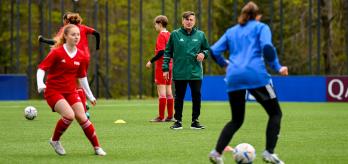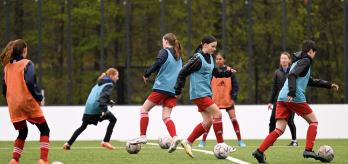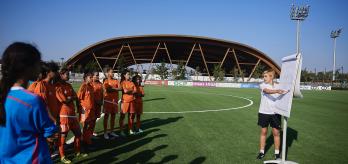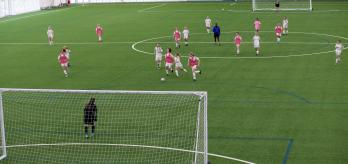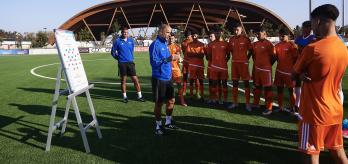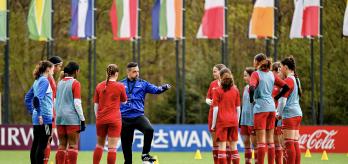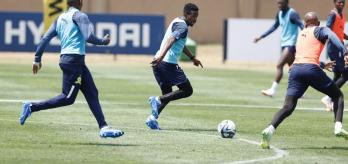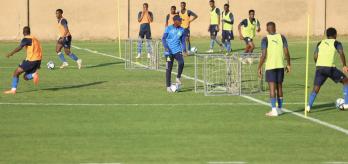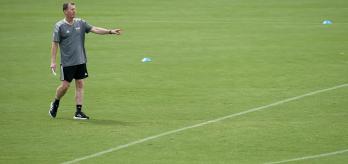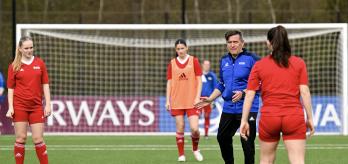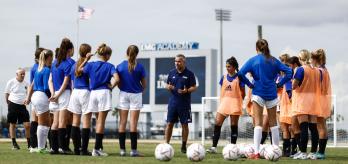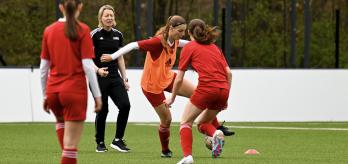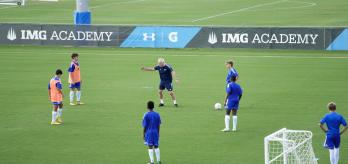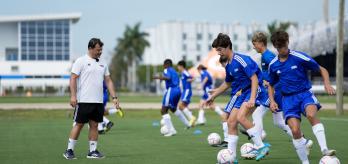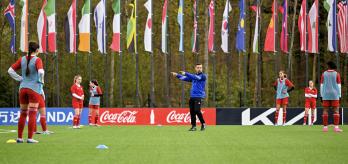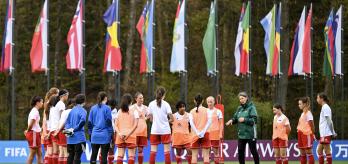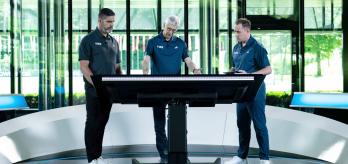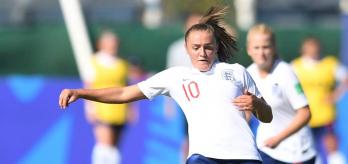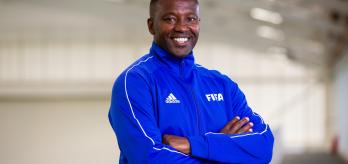One of the most effective methods to successfully breach an organised defence is for a wide midfielder to drop into the spaces in front of the defensive line, taking the defender with them. This results in space being created in the wide areas so that the full-back can roam into it and deliver a cross.
By using intelligent passages of play and runs, the centre-back, full-back and the wide midfielder can coordinate and combine to create effective movement patterns in order to open up a compact defence.
This session works on a range of these movement patterns and has been prepared by former England U-21 head coach, Aidy Boothroyd. Starting with an unopposed sequence that gives the players an opportunity to learn the best patterns, the session moves into a 10v10 game scenario in which they can implement these variations to great effect. It finishes with the same 10v10 game scenario, but on a smaller pitch, allowing the players to have more touches and presenting them with more possibilities to switch the play.
Session overview
Key coaching points
-
Confident and positive first touches will set the tone and allow players to coordinate movement patterns more effectively.
-
Players should time runs so that they are synchronised with the movement of their team-mates in order to produce coordinated phases of play.
-
The full-backs should stay wide in order to stretch the field of play and give the centre-backs more space to work in.
-
By getting into the space between the defensive and midfield line quickly, the wide midfielder can disrupt the opposition's defensive organisation and create spaces to exploit.
-
Players should focus on getting passes right in terms of the weight and whether they should be played to the back or front foot. Doing this will ensure that movement patterns are performed smoothly.
This session was designed with a specific game scenario in mind and seeks to tackle the question: how can a team in possession disrupt a compact and organised defence so that they can get the ball into the wide areas and then create goalscoring situations?
Part 1: unopposed movement patterns
This first exercise works through a number of movement patterns that can be used to build from the back via the wide areas of the pitch. By making good use of the spaces between the defensive and midfield lines, the wide midfielder can drop in to give their team several options to progress the ball into the final third.
-
Use a full-size pitch.
-
Put a goalkeeper in the goal at the top end of the pitch.
-
The players set up in a 4-2-3-1 formation (2 centre-backs, 2 full-backs, 2 centre-midfielders, 2 wide midfielders, 1 central attacking midfielder and 1 centre-forward).
-
Position 4 mannequins in a square-shaped area on both sides of the pitch just inside the opposition's half.
Up, back and through
-
The feeder (can be a coach) plays the ball into the centre-back.
-
As the centre-back carries the ball forward, the full-back has to match the pace of their run.
-
As the centre-back gets closer to the mannequins, the wide midfielder has to drop into the space between them to receive.
-
The centre-back plays the ball into the wide midfielder.
-
The wide midfielder passes inside to the centre-midfielder.
-
As the pass is being played, the full-back runs into the space in behind the defence.
-
The centre-midfielder then passes into the space for the full-back to latch onto.
-
At the same time, the wide midfielder runs into the penalty area.
-
The full-back crosses it into the waiting attackers, who try to score.
-
Once the passage of play finishes, repeat the sequence from the opposite side.
Switch of play
-
The feeder plays the ball into the centre-back.
-
The centre-back carries the ball forward.
-
As the centre-back gets closer to the mannequins, the wide midfielder has to drop into the space between them to receive.
-
The centre-back plays the ball into the wide midfielder.
-
The wide midfielder returns the pass to the centre-back.
-
The centre-back plays the ball to the centre-midfielder, who then passes to the second centre-midfielder.
-
At the same time, the wide midfielder on the opposite side makes a run into space up the flank.
-
The centre-midfielder switches play and plays a diagonal pass into the space for the wide midfielder to latch onto.
-
The centre-midfielders join the attackers in the area.
-
The wide midfielder has to cross and find the attackers, who try to score.
-
Repeat the sequence from the opposite side.
Option – instead of running down the line, the wide midfielder can come inside to receive the ball and play a pass into the full-back, who should make an overlapping run.
Feeder run
-
The feeder plays the ball into the centre-back.
-
As the centre-back carries the ball forward, the full-back has to match the speed of their run.
-
The wide midfielder has to drop into the space between the mannequins to drag the defending full-back in.
-
The centre-back plays out to the full-back.
-
The full-back plays down the line for the wide midfielder, who spins away from the mannequins.
-
The wide midfielder has to link with the two attacking players and create a 3v2 scenario against 2 defenders.
-
2 of the attacking players now become defenders to help create the 3v2. Rotate the attacking players so that they all get the opportunity to defend and attack.
-
The objective is to score inside the triangular zone in front of the goal.
Freedom to choose
-
The feeder plays the ball to the centre-back.
-
The centre-back carries the ball forward.
-
As the centre-back gets closer to the mannequins, the wide midfielder has to drop into the space between them to receive.
-
At this point, the players have to decide which of the 3 movement patterns they will execute.
-
The players should take a positive first touch so that the sequence runs smoothly and quickly.
-
The timing of runs is imperative and players should hold their runs as necessary so that they are synchronised with their team-mates' movement.
-
Positioning is a critical factor in each sequence. For example, full-backs should maintain width, but stay in tune with the centre-back, whereas centre-midfielders need to drop deep so they can open up play and pass to the opposite side.
-
The weight of passes is another crucial consideration, alongside whether they are played to the back or front foot.
-
Encourage centre-backs to get as close to the mannequins as possible before releasing the ball.
-
Once the players are familiar with their movement patterns, ask them to up the tempo to ensure that the drill is performed with the same intensity that there would be if there were opponents.
Part 2: 10v10 – opposed movement patterns
This phase of play encourages the players to put the previously practised movement sequences into action with opposition. The players need to decide which movement pattern can get them into a goalscoring situation depending on the conditions they face.
-
Use two thirds of a full-size pitch with a full-size goal at either end.
-
Set up the attacking team in a 4-2-3 formation.
-
Set up the defending team in a 4-4-1 formation.
-
Play always restarts with the feeder player (it can be the goalkeeper) from the attacking team.
-
The attacking team have to use movement patterns to break down the defending team and create goalscoring chances.
-
The defending team have to prevent the attacking team from scoring.
-
If the defending team win possession, they should move the ball forward and try to score at the other end.
-
Emphasise the significant importance of the wide midfielders and playing through the wide areas.
-
By coming inside, the wide midfielder will force the defending team to move out of position and provide space for the centre-back to be able to select a good pass.
-
When in possession, the centre-backs should split so that they can play through pressure and move the ball into the wide areas more quickly.
-
The combinations between the centre-back, the wide midfielder and the full-back are key. Through intelligent movement and a well-coordinated set-up, it is possible to exploit the space in the wide areas.
Part 3: 10v10 – reduced playing area
This final exercise is undoubtedly the most important part of the session, as the smaller pitch enables more touches for the players and increases the opportunity to switch the play when the defending team limit the space.
-
Mark out a 70x45m pitch.
-
Put a full-size goal at each end of the pitch.
-
Set up the attacking team in a 4-2-3 formation.
-
Set up the defending team in a 4-4-1 formation.
-
Play starts with the attacking team's goalkeeper.
-
The attacking team have to use movement patterns to break down the defending team and create goalscoring chances.
-
The defending team have to prevent the attacking team from scoring.
-
If the defending team win the ball, they should advance and try to score at the other end.
-
During build-up play, the players should use the most suitable form of movement pattern that they learned in the previous two exercises so that they can break down the defence and create goalscoring opportunities.
-
By taking up wide positions, the players will be able to stretch the opposition's structure and create space to exploit.
-
The players should be intelligent with their movement and runs so that space can be created in wide areas.
-
Encourage players to always be confident and positive with their first touch.
-
Players should focus on timed runs and synchronising movement between them and their team-mates in order to produce coordinated phases of play.
-
Players should also be attentive to their positioning and always be aware of their surroundings.
-
Teams should look to stretch play and get in behind when building attacks
-
Goalkeepers must decide when to initiate counter-attacks and when to slowly build from the back.
















